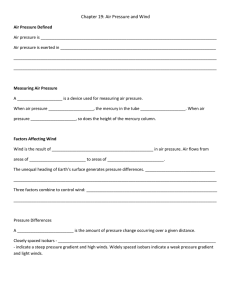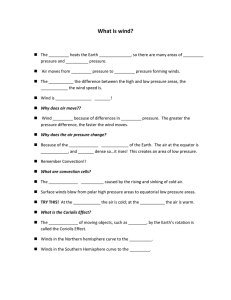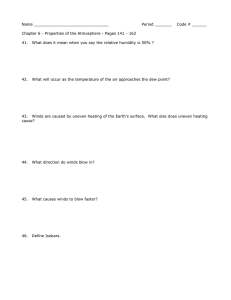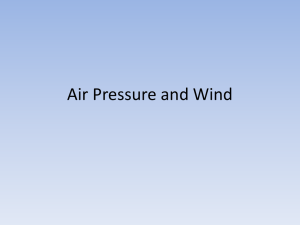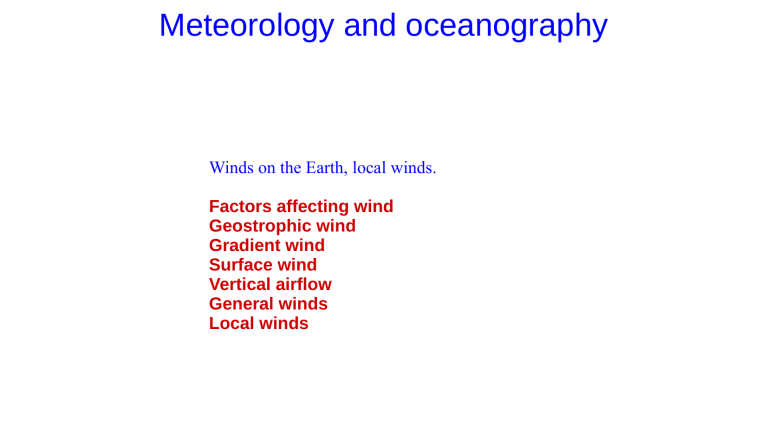
Meteorology and oceanography Winds on the Earth, local winds. Factors affecting wind Geostrophic wind Gradient wind Surface wind Vertical airflow General winds Local winds Wind. factors affecting wind Wind is the movement of atmospheric air relative to the Earth's surface. It is created due to uneven atmospheric pressure distribution in the atmosphere. Air flows from areas of higher pressure to areas of lower pressure. The wind compensates inequalities in the atmospheric pressure field. Unequal heating of Earth’s surface continually generates pressure differences. Solar radiation is the primary energy source for most wind. Wind. factors affecting wind If Earth didn’t rotate and if there were no friction, air would flow directly from areas of higher pressure to areas of lower pressure. Because both factors exist, wind is controlled by a combination of forces: ✔ pressure gradient force ✔ Coriolis force ✔ friction Wind. pressure gradient force In order for any particle to accelerate, it needs unbalanced force from one direction. The force that generates winds results from horizontal pressure differences. Pressure differences cause the wind to blow, and the greater these differences, the greater the wind speed. The value of the pressure gradient on the synoptic charts illustrates the density of the isobars - the smaller the distance between them, the higher the gradient and thus the stronger the wind blows. Wind. pressure gradient force H 1020 1016 1012 1008 1004 1000 L The pressure gradient is perpendicular to the isobar at every point. Wind. pressure gradient force A pressure gradient can be analyzed in the vertical dimension, with the prevailing trend being a downward gradient (toward the Earth's surface). Vertical pressure gradients are considered more substantially in terms of atmospheric lifting and instability. Surface-level winds and large, regional scale, airflow are more often analyzed in a horizontal sense. In areas underneath a gentle horizontal pressure gradient, where there is little change in the air pressure, the weather is generally calm and stable, with little wind or very light winds. In areas with a steep pressure gradient, the weather is often unstable and generally changeable. You can have moderate to severe winds, and moderate to severe weather (rain, snow, or sleet depending on temperature conditions and other factors). Wind. pressure gradient force The magnitude of the pressure gradient force is a function of the pressure difference between two points and air density. 1 Δp F FG = ∗ d Δn FFG – pressure gradient force d – density of air Δp – pressure difference between two points Δn – distance between two points , where Wind. pressure gradient force Pressure gradient degree is a change in the atmospheric pressure value per 1° distance on the meridian, or 60 NM (111 km). In meteorology, the distance = 100km was conventionally taken. In practice, we draw a perpendicular line between isobars, calculate its length in reality and calculate the pressure gradient (Pg) by reading value pressure differences between the isobars. For example: Pg = (4hPa * Δk [km]) / k [km] ,where - Δk :length of the segment corresponding to the assumed length of 100 km on the scale of a given map (k = 100km) - k :distance between two isobars (km) with a cut every 4hPa The air velocity is assumed to be approximately equal to three times the degree of pressure gradient expressed in hPa. Wind. Coriolis force The wind doesn’t cross the isobars at right angles, as the pressure gradient force directs. The deviation is the result of Earth's rotation and has been named the Coriolis force after the French scientist Gaspard Gustave Coriolis, who first expressed its magnitude numerically. All free-moving objects (including wind) are deflected to the right of their path in the Northern Hemisphere and the left in the Southern Hemisphere. © EarthHow.com Wind. Coriolis force The Coriolis force is the result of the difference in angular velocity and the linear velocity of the rotating Earth. © CC 3.0 Wind. Coriolis force Wind. Coriolis force After a few hours the winds along the 20th, 40th, and 60th parallels appear to be veering off course. Nevertheless, the Coriolis force is imperceptible to an observer unrelated to the reference system. When viewed from space, it is apparent that these winds have maintained their original direction. In fact, points on the surface of the Earth have changed their position during the rotation of the Earth around its axis. © Lutgens, Tarbuck Wind. Coriolis force Coriolis force acts to change the direction of a moving body to the right in the Northern Hemisphere, and to the left in the Southern Hemisphere. Coriolis force: - is always directed at right angles to the direction of airflow - affects only wind direction, not wind speed - is affected by wind speed (the stronger the wind, the greater the deflecting force) - is strongest at the poles and weakens equatorward, becoming nonexistent at the equator Wind. Coriolis force where: m - body weight, ω - vector of angular velocity of the rotating system, v - vector of the linear velocity of the body measured in a rotating reference system The Coriolis force does not affect the bodies that are at rest. The magnitude of the effect is given by: 2νω sin ϕ in which ν is the velocity of the object, ω is the angular velocity of the Earth, and ϕ is the latitude. Wind. Coriolis force Suppose that from the top of the high tower (from point A) we want to vertically drop some body. west At point A, it has a higher linear velocity than on the earth's surface (although the angular velocity is the same). During the flight from the tower, this body will move down due to the force of gravity and to the east - due to the inertia force, it will not drop to point B' but to point B'’. Free-falling bodies deflected to the east everywhere beyond the Earth's poles. east The body dropped from the top of the Eiffel Tower (height 273 m from the highest terrace) will fall shifted by 6.50103512 cm to the east. Wind. Coriolis force Is it a true that water goes down a sink in one direction in the Northern Hemisphere and in the opposite direction in the Southern Hemisphere? NO ! Typical sink is less then a meter in diameter and drains in a matter of seconds. On this scale the Coriolis force is minuscule. Therefore the shape of the sink and how level it is has more to do with the direction of the water flow than the Coriolis force. The difference between the angular and linear velocity of the Earth in the center and at the edge of the sink is almost imperceptible. Sneezing of a fly flying nearby may have a greater impact on the direction of water flow even :-) In case of an atmosphere situation, when we observe the contribution of Coriolis force, a typical cyclone is more than 1000 kilometers in diameter and may exist for several days. Then the Coriolis force has a significant value. You can read more about ‘fake Coriolis’ here: https://personal.ems.psu.edu/~fraser/Bad/BadCoriolis.html Wind. friction The pressure gradient force is the primary driving force of the wind. As an unbalanced force, it causes air to accelerate from regions of higher pressure to regions of lower pressure. Thus the wind speed should continually accelerate (increase) for as long as this imbalance exists. Some other force (or forces) must oppose the pressure gradient force to moderate airflow. As we know, friction acts to slow a moving object. The meaning of friction depends on the height above the surface of the Earth. Wind. geostrophic wind This type of airflow applies to the atmosphere at the height of a few kilometers, where the effects of friction are small enough to disregard. Initially, the parcel of air does not move, the Coriolis force does not affect it, therefore, only the force of the pressure gradient acts. As a result of the force of the pressure gradient, the particle begins to move perpendicular to the isobar towards the low pressure region. As soon as the flow begins, the Coriolis force comes into play and causes a deflection to the right for wind in the Northern Hemisphere (left in the Southern Hemisphere). © Lutgens, Tarbuck Wind. geostrophic wind As the parcel continues to accelerate, the Coriolis force intensifies, because the magnitude of the Coriolis force is proportional to wind speed. Then, the increased speed results in further deflection. Finally the wind turns so that it is flowing parallel to the isobars. The pressure gradient force is balanced by the opposing Coriolis force. As long as these forces remain balanced, the resulting wind will continue to flow parallel to the isobars at a constant speed. Wind. geostrophic wind Under these idealized conditions the Coriolis force is exactly equal and opposite to the pressure gradient force, the airflow is in so called geostrophic balance (geostrophic means: turned by Earth). Geostrophic winds flow in a straight path, parallel to the isobars, with velocities proportional to the pressure gradient force. A high pressure gradient creates strong winds, a weak pressure gradient creates light winds. In a real atmosphere, such a movement can occur only in a free atmosphere (>500m). Such conditions exist above the friction layer, where the isobars are close to straight lines. Wind. gradient wind Geostrophic winds exist in locations where there are no frictional forces and the isobars are straight. However, such locations are quite rare. Isobars are almost always curved and are very rarely evenly spaced. This changes the geostrophic winds so that they are no longer geostrophic but are instead in gradient wind balance. They still blow parallel to the isobars, but are no longer balanced by only the pressure gradient and Coriolis forces, and do not have the same velocity as geostrophic winds. Wind. gradient wind The gradient wind wind blows in a free atmosphere, above the friction layer, around a circular isobar. The forces here are Coriolis force, centrifugal force and pressure gradient force. The gradient wind, similar to the geostrophic one, blows parallel to the isobar, leaving a lower pressure on the northern hemisphere on the left side, and on the southern hemisphere on the right side. the initial route of the air © Lutgens, Tarbuck Wind. gradient wind In this case, the centrifugal force acts in the same direction as the Coriolis force. As the parcel moves north, it moves slightly away from the center - decreases the centrifugal force. The pressure gradient force becomes slightly more dominant and the parcel moves back to the original radius. This allows the gradient wind to blow parallel to the isobars. © ww2010.atmos.uiuc.edu Wind. gradient wind Since the pressure gradient force doesn't change, and all the forces must balance, the Coriolis force becomes weaker. This in turn decreases the overall wind speed. This is where the gradient wind differs from the geostrophic winds. In this case of a low pressure system or trough, the gradient wind blows parallel to the isobars at a less than geostrophic speed. Wind. gradient wind In this case, again starting from point A, the geostrophic wind will blow straight south. This time the centrifugal force is pushing in the same direction as the pressure gradient force, and when it gets slightly further away from the center, the centrifugal force again reduces, but this time that makes the Coriolis Force more dominant and the air parcel will move back to its original radius - again with the end result being wind blowing parallel to the isobars. © ww2010.atmos.uiuc.edu Wind. gradient wind Since the pressure gradient force still doesn't change, the Coriolis force must again adjust to balance the forces. However now it becomes stronger, which in turn increases the overall wind speed. This means that in a high pressure system or ridge, the gradient wind blows parallel to the isobars faster than geostrophic speed. Wind. surface wind Friction as a factor affecting wind is important only within the first few kilometers of Earth’s surface. Friction acts to slow the movement of air. Friction also reduces the Coriolis force, which is proportional to wind speed. Air flow at an angle across the isobars, toward the area of lower pressure. In this way, there is a gradual equalization of pressure between the areas of higher and lower pressure. The deflection and slowing effect of friction decreases with the height. A significant increase in speed is already recorded 30-50m above the ground. © Lutgens, Tarbuck Wind. surface wind In the Northern Hemisphere winds blow counterclockwise around a cyclone and clockwise around an anticyclone, with winds nearly parallel to the isobars. When we add the effect of friction, we notice that the airflow crosses the isobars at varying angles, depending on the roughness of the terrain, but always from higher to lower pressure. In whatever hemisphere, friction causes a net inflow (convergence) around a cyclone and a net outflow (divergence) around an anticyclone. Wind. surface wind Environment Canada – national marine weather guide Wind. surface wind The roughness of the terrain determines the angle at which the air flow across the isobars as well as influence the speed at which it will move. Over smooth ocean surface, where the friction is low, air moves at an angle of 10° to 20° to the isobars and at speed roughly two-thirds of geostrophic flow. Over rugged terrain, where fiction is high, the angle can be as great as 45° from the isobars, with wind speed reduced by as much as 50 percent. © ww2010.atmos.uiuc.edu Wind. vertical airflow Cyclonic circulation has converging surface winds and rising air causing cloudy conditions. Anticyclonic circulation has diverging surface winds and descending air, which provides clear skies and fair weather. © Lutgens, Tarbuck Surface convergence about a cyclone causes a net upward movement. The rate of this vertical movement is slow, generally less than 1 kilometers per day. However it’s enough to create a cloud cover and precipitations. Wind. vertical airflow Friction can cause convergence and divergence in several ways. When air flows from the relatively smooth ocean surface onto land, the increased friction causes an abrupt drop in wind speed. This reduction of wind speed results a pile-up of an air stream. Thus, converging winds and ascending air accompany flow off the ocean. This effect contributes to the cloudy conditions over land often associated with a sea breeze in a humid regions. Conversely, when air flows from land onto the ocean, general divergence and subsidence accompany the seaward flow of air because of lower friction which increases wind speed over the water. Wind. winds distribution Zonal wind distribution according to the three-cell global circulation model. © Lutgens, Tarbuck Wind. winds distribution Wind. winds distribution Wind. local winds Local winds appear in a given area at specific times of a day or a year and show a significant independence from the general atmosphere circulating in a given place. These local circulations overlap with the general circulation and can sometimes significantly or even completely change its most important features. ►Local winds may be the result of air circulation having a local range, independent of the general atmospheric circulation, but overlapping with it. An example of such winds are sea breezes and mountain breezes. ►Another type of local winds are currents of the general atmosphere circulation, which under the influence of local factors (eg, orography) are deformed. An example of this type of wind is fen or bora. ►Sometimes, as local winds, characterized by a characteristic specificity, we treat small air currents that are actually currents of the general atmosphere circulation. Such winds include, for example, sirocco, hamsin, samum. Wind. local winds – sea breeze © Lutgens, Tarbuck Wind. local winds – valley/mountain breeze (anabatic/katabatic wind) © Lutgens, Tarbuck Wind. local winds – foehn type winds (foehn, halny, chinook, fén-fēng, etc.) Wind. local winds – most known local winds on the Earth Wind. local winds – most known local winds of North America The Norther This name for a wind is used in more than one place. In Chile, a Norther is a northerly gale with rain. It usually occurs in winter but occasionally occurs at other times of year. Typically, it can be identified by falling air pressure, a cloudy or overcast sky, good visibility and water levels below normal along the coast. Over the Gulf of Mexico and western parts of the Caribbean Sea, Northers are strong, cool, northerly winds which blow mainly in winter. Over the Gulf of Mexico, they are sometimes humid and accompanied by precipitation, but over the Gulf of Tehuantepec they are dry winds. Wind. local winds – most known local winds of North America Chinook (warm dry westerly off the Rocky Mountains) Chinook winds (Chinooks), are foehn winds in the interior West of North America, where the Canadian Prairies and Great Plains meet various mountain ranges, although the original usage is in reference to wet, warm coastal winds in the Pacific Northwest. A strong wind can make snow 30 cm deep almost vanish in one day. The snow partly melts and partly sublimates in the dry wind. Chinook winds have been observed to raise winter temperature, often from below −20°C to as high as 10–20°C for a few hours or days, then temperatures plummet to their base levels. The greatest recorded temperature change in 24 hours was caused by Chinook winds on 15 January 1972, in Loma, Montana; the temperature rose from −48°C to +9°C. Where Chinooks occur most frequently. Wind. local winds – most known local winds of North America Blizzards A blizzard is a severe snowstorm characterized by strong sustained winds of at least (56 km/h) and lasting for a prolonged period of time — typically three hours or more. A ground blizzard is a weather condition where snow is not falling but loose snow on the ground is lifted and blown by strong winds. Blizzards can have an immense size, which can usually be larger than a few states in the United States. A nor'easter is a macro-scale storm that occurs off the New England and Atlantic Canada coastlines. It gets its name from the direction the wind is coming from. The usage of the term in North America comes from the wind associated with many different types of storms some of which can form in the North Atlantic Ocean and some of which form as far south as the Gulf of Mexico. The term is most often used in the coastal areas of New England and Atlantic Canada. This type of storm has characteristics similar to a hurricane. Wind. local winds – most known local winds of South America Pampero (Argentina), very strong wind which blows in the Pampa. The pampero is a burst of cold polar air from the west, southwest or south on the pampas in the south of Brazil, Argentina, Uruguay, Paraguay and Bolivia. This wind (often violently) picks up during the passage of a cold front of an active low passing by. It takes the form of a squall line. There is a marked drop in temperature after its passing. The Pampero is most common at winter in the southern hemisphere (May to August). During the summers in the region around Buenos Aires, the pampero storms are a welcome sing marking the end of long periods of high humidity and extreme heat. Wind. local winds – most known local winds of Australia Southerly (Southerly Buster) - rapidly arriving low pressure cell that dramatically cools Sydney, Australia during summer. These storms can be cold and have bad weather. In Wellington, New Zealand these storms are normally short and frequently have winds gusting between 120 km/h and 160 km/h though higher speeds are known. Wind. local winds – most known local winds of Australia Brickfielder A hot, dry, dusty wind of southern or central Australia. Name of wind from the location name Brickfield Hill, after the hill in Surry Hills (now in inner Sydney) from the direction of which a hot wind blew into Sydney in its early days. Black nor'easter Persistent and potentially violent Sydney northeasterly storm is known as a "black nor'easter". This is not a convection wind, but a storm system that develops offshore which can last several days. This is heralded by the rapid build-up of dense black cloud that can convert to a gale in well under one hour. Wind. local winds – most known local winds of Africa Sirocco It arises from a warm, dry, tropical air-mass that is pulled northward by low-pressure cells moving eastward across the Mediterranean Sea, with the wind originating in the Arabian or Sahara deserts. The hotter, drier continental air mixes with the cooler, wetter air of the maritime cyclone, and the counter-clockwise circulation of the low propels the mixed air across the southern coasts of Europe. The sirocco's duration may be as short as half a day or may last several days. While passing over the Mediterranean Sea, the sirocco picks up moisture; this results in rainfall in the southern part of Italy, known locally as "blood rain" due to the red sand mixed with the falling rain. Wind. local winds – most known local winds of Africa Khamsin Dry, hot, sandy local wind, blowing from the south, in North Africa and the Arabian Peninsula. From the Arabic word for "fifty", these windstorms often blow sporadically over a fifty-day period in spring, hence the name. When the storm passes over an area, lasting for several hours, it carries great quantities of sand and dust from the deserts, with a speed up to 140 km/h, and the humidity in that area drops below 5%. Even in winter, the temperatures rise above 45°C due to the storm. Wind. local winds – most known local winds of Africa Harmattan Dry and dusty northeasterly trade wind, which blows from the Sahara Desert over West Africa into the Gulf of Guinea. The Harmattan blows during the dry season, which occurs during the lowest-sun months. In this season the subtropical ridge of high pressure stays over the central Sahara Desert and the low-pressure Intertropical Convergence Zone (ITCZ) stays over the Gulf of Guinea. On its passage over the Sahara, the harmattan picks up fine dust and sand particles (between 0.5 and 10 microns). Wind. local winds – most known local winds of Africa Haboob A haboob is a type of intense dust storm carried on an atmospheric gravity current, also known as a weather front. Haboobs occur regularly in dry land area regions throughout the world. African haboobs result from the northward summer shift of the inter-tropical front into North Africa, bringing moisture from the Gulf of Guinea. Haboobs have been observed in the Sahara desert (typically Sudan, where they were named and described), as well as across the Arabian Peninsula, throughout Kuwait, and in the most arid regions of Iraq. Haboob winds in the Arabian Peninsula, Iraq, Kuwait are frequently created by the collapse of a thunderstorm. Wind. local winds – most known local winds of Africa Berg Wind When the air that has been heated on the extensive central plateau flows down the escarpment to the coast it undergoes further warming by adiabatic processes. This accounts for the hot and dry properties of these off-shore winds, wherever they occur along South Africa's coastline. Berg winds are usually accompanied by coastal lows. These coastal lows owe their existence to the configuration of the plateau, escarpment and coastal plain, in that they are confined to the coastal areas, always below the escarpment. Though they can arise almost anywhere along the coast, they often first appear on the west coast, or even on the Namibian coast. Wind. local winds – most known local winds of Asia Buran Wind which blows across Iran, eastern Asia, specifically Xinjiang, Siberia, and Kazakhstan. Over the tundra, it is also known as purga. It is a wind of cold air, sometimes very strong, characteristic of the steppes of the East European Plain, to the west of the Urals. The buran takes two forms: in summer, it is a hot, dry wind, whipping up sandstorms; in winter, it is bitterly cold and often accompanied by blizzards. Winter buran winds are strong and full of ice and snow. The sky is often laden with snow, which swirls about and reduces the visibility to near zero at times. In Alaska this severe northeasterly wind is known as burga and brings snow and ice pellets. Wind. local winds – most known local winds of Asia Karaburan Also called black storm, black buran. A violent northeast wind of Central Asia occurring during spring and summer. It resembles the white buran of winter but, instead of snow, it carries clouds of dust that darken the sky. Wind. local winds – most known local winds of Europe Helm The Helm Wind is a named wind in Cumbria, England, a strong north-easterly wind which blows down the south-west slope of the Cross Fell escarpment. It is the only named wind in the British Isles, although many other mountain regions in Britain exhibit the same phenomenon when the weather conditions are favourable. Wind. local winds – most known local winds of Europe Bora The bora is a northern to north-eastern katabatic wind in the Adriatic Sea. Similar nomenclature is used for north-eastern winds in other littoral areas of eastern Mediterranean and Black Sea basins. The bora is most common during the winter. It blows hardest when a polar high-pressure area sits over the snow-covered mountains of the interior plateau behind the Dinaric coastal mountain range and a calm low-pressure area lies further south over the warmer Adriatic. As the air grows even colder and thus denser at night, the bora increases. Its initial temperature is so low that even with the warming occasioned by its descent it reaches the lowlands as a cold wind. Wind. local winds – most known local winds of Europe Mistral Strong, cold, northwesterly wind that blows from southern France into the Gulf of Lion in the northern Mediterranean, with sustained winds often exceeding 66 km/h, sometimes reaching 185 km/h. It is most common in the winter and spring, and strongest in the transition between the two seasons. Periods of the wind exceeding 30 km/h for more than sixty-five hours have been reported. The mistral is usually accompanied by clear, fresh weather. The mistral usually blows in winter or spring, though it occurs in all seasons. It sometimes lasts only one or two days, frequently lasts several days, and sometimes lasts more than a week. Wind. local winds – most known local winds of Europe Foehn Foehn is a warm, dry, gusty wind which occurs over the lower slopes on the lee side (the side which is not directly exposed to wind and weather) of a mountain barrier. Wind. local winds – most known local winds of Europe Levant A moist wind which blows from the east over the Strait of Gibraltar. It is frequently accompanied by haze or fog and may occur at any time of year, though it is most common in the period June to October. A feature is the occurrence of a ‘banner cloud’ extending a kilometer or more downwind from the summit of the Rock of Gibraltar. The strength of the Levant does not normally exceed Beaufort Force 5. When it is strong, however, complex and vigorous atmospheric eddies form in the lee of the Rock, causing difficult conditions for yachtsmen and the pilots of aircraft. The Levant can also cause persistently foggy weather on the coast of Spain. Wind. local winds – most known local winds of Europe Etesians (Meltemi) The strong northerly winds which blow at times over the Aegean Sea and eastern parts of the Mediterranean Sea during the period May to October. The winds are known as Meltemi in Turkey. commons.wikimedia.org Wind. local winds – most known local winds of the Mediterranean © 1yachtua.com
